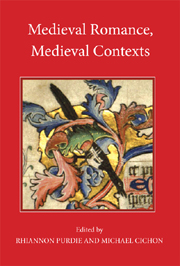Book contents
- Frontmatter
- Contents
- Acknowledgements
- Contributors
- Abbreviations
- Introduction: Romance and its Medieval Contexts
- 1 The Pleasure of Popular Romance: A Prefatory Essay
- 2 Representations of Peasant Speech: Some Literary and Social Contexts for The Taill of Rauf Coilyear
- 3 ‘As ye have brewd, so shal ye drink’: the Proverbial Context of Eger and Grime
- 4 Ekphrasis and Narrative in Emaré and Sir Eglamour of Artois
- 5 What's in a Name? Anglo-Norman Romances or Chansons de geste?
- 6 ‘For Goddes loue, sir, mercy!’: Recontextualising the Modern Critical Text of Floris and Blancheflor
- 7 Roland in England: Contextualising the Middle English Song of Roland
- 8 Romance Baptisms and Theological Contexts in The King of Tars and Sir Ferumbras
- 9 Modern and Medieval Views on Swooning: the Literary and Medical Contexts of Fainting in Romance
- 10 Walking (between) the Lines: Romance as Itinerary/Map
- 11 Romances of Continuity in the English Rous Roll
- 12 ‘Ex Libris domini duncani / Campbell de glenwrquhay/ miles’: The Buik of King Alexander the Conquerour in the household of Sir Duncan Campbell, seventh laird of Glenorchy
- 13 ‘Pur les francs homes amender’: Clerical Authors and the Thirteenth-Century Context of Historical Romance
- Index
- Volumes already published
10 - Walking (between) the Lines: Romance as Itinerary/Map
Published online by Cambridge University Press: 12 September 2012
- Frontmatter
- Contents
- Acknowledgements
- Contributors
- Abbreviations
- Introduction: Romance and its Medieval Contexts
- 1 The Pleasure of Popular Romance: A Prefatory Essay
- 2 Representations of Peasant Speech: Some Literary and Social Contexts for The Taill of Rauf Coilyear
- 3 ‘As ye have brewd, so shal ye drink’: the Proverbial Context of Eger and Grime
- 4 Ekphrasis and Narrative in Emaré and Sir Eglamour of Artois
- 5 What's in a Name? Anglo-Norman Romances or Chansons de geste?
- 6 ‘For Goddes loue, sir, mercy!’: Recontextualising the Modern Critical Text of Floris and Blancheflor
- 7 Roland in England: Contextualising the Middle English Song of Roland
- 8 Romance Baptisms and Theological Contexts in The King of Tars and Sir Ferumbras
- 9 Modern and Medieval Views on Swooning: the Literary and Medical Contexts of Fainting in Romance
- 10 Walking (between) the Lines: Romance as Itinerary/Map
- 11 Romances of Continuity in the English Rous Roll
- 12 ‘Ex Libris domini duncani / Campbell de glenwrquhay/ miles’: The Buik of King Alexander the Conquerour in the household of Sir Duncan Campbell, seventh laird of Glenorchy
- 13 ‘Pur les francs homes amender’: Clerical Authors and the Thirteenth-Century Context of Historical Romance
- Index
- Volumes already published
Summary
‘What can we know of the world? What quantity of space can our eyes hope to take in between our birth and our death? How many square centimetres of Planet Earth will the soles of our feet have touched?’
As Georges Perec observes, our personal experience of the world is lamentably finite. As much – or as little – as one seeks to travel, one will never experience the entire world. The only way we can know the world outside of our personal experience is necessarily at a remove. Our geographical knowledge of the overwhelming majority of the world is thus mediated through text, image, narrative. No less true for the modern age, this was particularly the case during the medieval period, where the geographical radii of peoples' lives, as well as their exposure to geographical media, were commonly more restricted than today. However, just as we today experience the world through National Geographic, travel shows and the aspirational reading of Lonely Planet guidebooks, the people of the medieval period also revelled in travel narratives. In the Auchinleck manuscript narrative of Guy of Warwick, the eponymous protagonist travels throughout Europe, from Warwick to Normandy, through Spain, Germany, Lombardy and thence onwards to more exotic locales such as Constantinople, Jerusalem, Bethlehem and Alexandria. His travels chart his development as first a chivalric and later a Christian hero, transforming him from an ideal lover-knight into the embodiment of the pious martial pilgrim.
- Type
- Chapter
- Information
- Medieval Romance, Medieval Contexts , pp. 135 - 148Publisher: Boydell & BrewerPrint publication year: 2011



